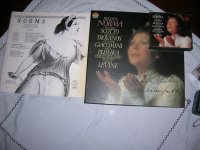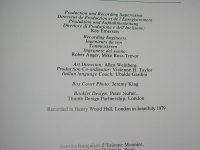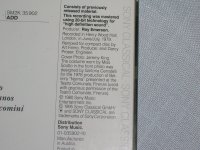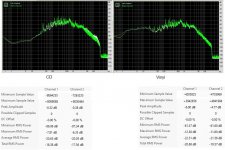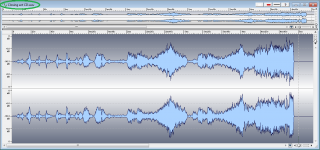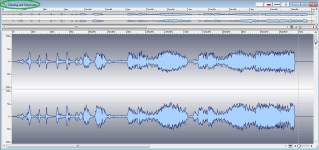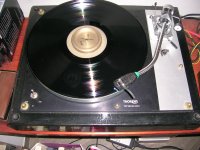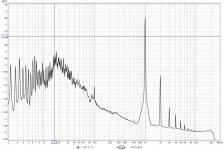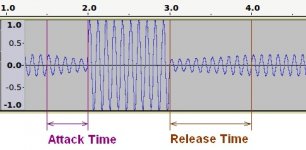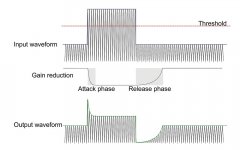The reason I brought the whole thing up was Evenharmonics's claim that you can see that CD is superior to vinyl records by looking at the technical performance. That's true if you are into high signal-to-noise ratios or low close-in phase noise a.k.a. wow and flutter, but not if you are into smooth ultrasonic roll-off, especially not when you use an MC cartridge.
Please read more carefully what I wrote. I did not claim having heard anything. Those claims were made by somebody else. I just pointed out design flaws visible in the FFT but which are totally fixable. I can also accept that FFT does not reveal all there is to these flaws and they may even be audible in some circumstances. Why make such a sloppy design? I don't see why this should be different to your 0.00000....0001 % amp designs.Do you really believe in audibility of something that is all below -130dBr?? Have you tried to calculate such differences into SPL? What would be the mechanism of hearing such thing? Have you done any DBT to support your claims? Because usupported opinion does not count.
IME wide and high noise skirt is caused by poor clocking and high lf noise in Vref. I don't see why both of those flaws could not be audible in some circumstances even though they appear to be 140dB below the fundamental in FFT.How is any of that going to be audible? It's buried completely within the noise. The only reason you can see them there is because of the FFT process used to extract them from the noise itself. They are all almost 140dB below the fundamental, this is ~20dB below the noise floor of the DAC.
FFTs have not failed as they just show your designs having -85dB THD vs. -120dB in Sabre DAC. As discussed before in this thread "sound better" may just indicate that you prefer the distortions and time-invariant flaws in your TWSDACs.FFTs are pretty useless since they are time-invariant measurements.
TWSDAC-1862 and TWSDAC-1541 aren’t transformer coupled, they share the same I/V converter, folded cascode with zero negative feedback. Simulation gives around -85dB of THD.
At the end they sound much better than the -120dB Sabre DAC. Which confirms that the FFTs fail.
Many prefer distortion. More than once I improved/replaced power supplies and circuits and was told the old sound was better. Some prefer non regulated power over IC regulators. From clearly visible ripple voltage to a thin line and gone was the good sound  Even DACs with a unusual high THD are preferred by many in a listening test. Often this is in the tube world where science is heresy and ears are instruments. Some know beforehand that ESS DACs can not sound good without listening to them.
Even DACs with a unusual high THD are preferred by many in a listening test. Often this is in the tube world where science is heresy and ears are instruments. Some know beforehand that ESS DACs can not sound good without listening to them.
On the other hand I have an ES9028K2M DAC here that measures very good but I don't like the sound of it. Now who is "right"?
On the other hand I have an ES9028K2M DAC here that measures very good but I don't like the sound of it. Now who is "right"?
Last edited:
Many prefer distortion. More than once I improved/replaced power supplies and circuits and was told the old sound was better. Some prefer non regulated power over IC regulators. From clearly visible ripple voltage to a thin line and gone was the good sound
Hard to draw any conclusions from these experiences. Improved power supplies do not necessarily lead to less distortion, especially at normal listening levels. Whatever changed is not something fft is likely to catch.
The ripple argument is also weak as many who detest regulation love batteries. Or multistage passive filtering with a similar level of ripple as regulation.
Many prefer distortion. More than once I improved/replaced power supplies and circuits and was told the old sound was better. Some prefer non regulated power over IC regulators. From clearly visible ripple voltage to a thin line and gone was the good soundEven DACs with a unusual high THD are preferred by many in a listening test. Often this is in the tube world where science is heresy and ears are instruments. Some know beforehand that ESS DACs can not sound good without listening to them.
On the other hand I have an ES9028K2M DAC here that measures very good but I don't like the sound of it. Now who is "right"?
WRT distortion and power supplies, 100% agreed. We listen to it every day in our recordings. Look inside any Studer A80 or Ampex ATR = distortion city.
Best DAC I have had in my system of recent times was an MSB Discrete multibit. Clearly this would not measure up objectively to a well implemented ESS DAC such as Topping D90SE.
TCD
A lot of noise, a lot of distortion with vinyl. But despite of that (or is it due to that?) it sounds OK
So much so that I have the suspicion that digging for lower and lower levels of noise and distortion with DACs is like digging in the wrong place.
I have a few vinyls and their official transfer to CD and some with a later remastering. They are enough in number to allow me forming an opinion that there is nothing wrong with the digitalization but there can be a lot to blame the one who has done it.
Yesterday I found a file in my hard drive with a vinyl rip I had made for comparison to the remastered CD. Shure M97xE cartridge, Hagerman Bugle RIAA preamp with batteries.
Norma closing act CD
https://www.dropbox.com/s/huje2pjbebjohmb/Closing act CD.wav?dl=0
Norma closing act Vinyl
https://www.dropbox.com/s/r0q44xvrf6vjjxe/Closing act Vinyl.wav?dl=0
Apart from the weaker ending (compared to the remastered CD), do you find the vinyl sounding worse than the CD in the rest of the music extract?
Last attachment is the FFT of 1kHz@5cm/sec from the TT system with which the vinyl rip was made (The Ultimate Test LP. S1, T1).
George
So much so that I have the suspicion that digging for lower and lower levels of noise and distortion with DACs is like digging in the wrong place.
I have a few vinyls and their official transfer to CD and some with a later remastering. They are enough in number to allow me forming an opinion that there is nothing wrong with the digitalization but there can be a lot to blame the one who has done it.
Yesterday I found a file in my hard drive with a vinyl rip I had made for comparison to the remastered CD. Shure M97xE cartridge, Hagerman Bugle RIAA preamp with batteries.
Norma closing act CD
https://www.dropbox.com/s/huje2pjbebjohmb/Closing act CD.wav?dl=0
Norma closing act Vinyl
https://www.dropbox.com/s/r0q44xvrf6vjjxe/Closing act Vinyl.wav?dl=0
Apart from the weaker ending (compared to the remastered CD), do you find the vinyl sounding worse than the CD in the rest of the music extract?
Last attachment is the FFT of 1kHz@5cm/sec from the TT system with which the vinyl rip was made (The Ultimate Test LP. S1, T1).
George
Attachments
Do you really believe in audibility of something that is all below -130dBr?? Have you tried to calculate such differences into SPL? What would be the mechanism of hearing such thing?
There is only one pressure wave that impinges on the ear. The idea that spectral components can be linearly separated is based on an assumption of a linear detector. However, we know that if a detector has a certain nonlinearity, i.e. a detection threshold, that in some cases stochastic resonance (the addition of random noise to an input signal below the threshold) can boost the composite input (noise + signal) over the threshold such that the smaller signal can be detected.
Seems to me the burden of proof is on you to show that the ear/brain detector system is linear for complex time domain waveforms, not just for simple sinusoids taken in isolation.
Last edited:
Many prefer distortion.
Do you mean simple time-invariant weak nonlinearity (which I don't think people like, at least not on average), or do you mean a certain type of time-variant nonlinearity that helps compensate perceptually for imperfections in recording accuracy (which may be perceived as more like live music to some people in some cases)?
Maybe you don't know, since typical FFT analysis does not show the latter case very clearly?
I'd prefer to read about those listening tests that provide the evidence for your assertion.There are many types of listening tests done. Which type do you prefer to read about?
As for the definition of correct result I brought up on post #301 goes...?
Correct results are results that are equal to the real/true value of the parameter under examination.
D
Deleted member 537459
Not exactly. This just indicates that all the people who joined the listening session recognized a Steinway grand piano when played by the zero feedback -85dB DACs, while the same piano has not been recognized as realistic when played by the -120dB DACs.FFTs have not failed as they just show your designs having -85dB THD vs. -120dB in Sabre DAC. As discussed before in this thread "sound better" may just indicate that you prefer the distortions and time-invariant flaws in your TWSDACs.
This means that FFTs fail.
D
Deleted member 537459
With opamps and 150dB feedback you can achieve -120dB of THD, while you cannot with zero feedback designs. Moreover the TDA1541A is a 16 bit DAC, so it’s dynamic is limited to 96dB.-85dB on a DAC? .... ummm The Purify Sub drivers have lower distortion than that
FFT did not fail as its purpose is to measure THD which it did correctly. I have played Steinway grand pianos and others as well. On recordings and live they sound very different depending on the location.Not exactly. This just indicates that all the people who joined the listening session recognized a Steinway grand piano when played by the zero feedback -85dB DACs, while the same piano has not been recognized as realistic when played by the -120dB DACs.
This means that FFTs fail.
A bit more about distortion. Attached below are a couple of pics showing what a dynamics compressor does. They are pretty exaggerated examples to illustrate a point. The point is that if you feed a fixed sine wave test signal into one and measure the distortion, you will have no idea of what the thing actually does to sound. You will see something that looks like a time-invariant nonlinearity simply because you are measuring it in a time invariant way. You may wrongly conclude that a black box simply produces distortion, so people must like distortion. Wrong conclusion. It isn't that simple.
Okay. What do you suppose a loosely regulated power supply does? What effect might it have on an amplifier circuit? Think about it. Is it a simple time-invariant distortion and nothing more? Will any other random distortion do just as well? Why might some people like it?
Okay. What do you suppose a loosely regulated power supply does? What effect might it have on an amplifier circuit? Think about it. Is it a simple time-invariant distortion and nothing more? Will any other random distortion do just as well? Why might some people like it?
Attachments
Well I decided NOT to think about why others prefer distortion of kinds and just follow my own path. When I deliver a good measuring and sounding prototype device for evaluation to person A that is enthusiastic and person B can decide how bad the very same device is by only knowing the DAC IC then I know what to do. I have heard good devices being rejected in setups that literally were distorting or in non standard configuration (GAIN!!!!) and the newcomer device with standardized output signal levels was blamed. So to make it simple one better designs and builds what one thinks is good and leave opinions to others with a smile.
A PSU must have at least some parameters that are defined and need to be optimized for its load. Preferring an unregulated PSU with high ripple voltage that can be found in the output signal is end of discussion anyway even if the end result has a certain appeal.
As said, the trouble and difficulty begin when a device measures exemplary but sounds mediocre. Apparently not everything measured correlates to good sound. Sometimes mediocre measuring devices are preferred by some too. Most difficult is when different people have complete opposite opinions listening to the very same device at the same time in one room
A PSU must have at least some parameters that are defined and need to be optimized for its load. Preferring an unregulated PSU with high ripple voltage that can be found in the output signal is end of discussion anyway even if the end result has a certain appeal.
As said, the trouble and difficulty begin when a device measures exemplary but sounds mediocre. Apparently not everything measured correlates to good sound. Sometimes mediocre measuring devices are preferred by some too. Most difficult is when different people have complete opposite opinions listening to the very same device at the same time in one room
Last edited:
D
Deleted member 537459
In the real world the Steinway is always recognizable not depending on the location. FFTs fail because are time-invariant measurements, the Steinway never plays 1kHz sine wave.FFT did not fail as its purpose is to measure THD which it did correctly. I have played Steinway grand pianos and others as well. On recordings and live they sound very different depending on the location.
- Status
- Not open for further replies.
- Home
- Source & Line
- Digital Line Level
- The battle of the DACs, comparison of sound quality between some DACs
